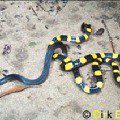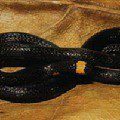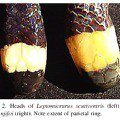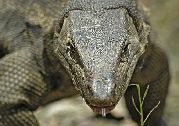
Asp slender collared
The slender collared asp (Leptomicrurus collaris) is a relatively young and rather rare species from the family of aspids (Elapidae). Together with the Arizona and coral asp, he is part of the American aspid group. Moreover, all three genera – slender, Arizona and coral asps – are sometimes combined under the name of American coral asps. However, the slender collared asp, unlike other members of the group, can be called endemic to the Amazon basin, since it is the original inhabitant of these places and is only occasionally found in other parts of the mainland. This snake got its name due to its slender, graceful body, by which it is not so easy to determine where the head and where the tail is – both are decorated with thin yellow rings. Like all aspids, the slender collared asp is venomous. But all his weapons are two relatively short poisonous fangs on the upper jaw, so the snake bites extremely reluctantly and only in rare, most dangerous cases.
Contents
Classification
Kingdom: Animals
Type: Chordates Subtype: Vertebrates
Class: Reptiles Order: Scaly Suborder: Snakes Family: Asps
Genus: slender asps or coral black-backed snakes, Leptomicrurus
Species: slender collared asp Leptomicrurus collaris
Appearance
 Nothing happens by chance in nature. So the slender asp is not at all accidentally called collar. This almost completely black snake has a yellow stripe on the neck and tail that closes across the body. Therefore, in fact, the slender collared asp has two “collars”. Moreover, the shape of its tail – short and blunt – is often confusing, not allowing you to immediately determine where the snake’s head is. The venomous fangs of the slender collared asp, like those of all its relatives, are located on the upper jaw, slightly in front, and are equipped with a venom-conducting canal, which in the form of a groove extends to the front surface of the canine. The teeth of this snake, like all primitive members of the family, are motionless. Other features that unite the slender collared asp with the Elapidae are: larger shields of skin on the head of a rounded shape, smoothly, almost without cervical narrowing, passing into the body, as well as eyes with a round pupil, for example, in contrast to vipers, in which the pupil is vertical. On the body from below, as well as on the head, there are larger abdominal shields. And of course, the slender collared asp, also due to its small size, resembles a snake. The presence of bright stripes of different colors distinguishes all coral snakes, only rare exceptions living in South America may not have them. But sometimes there are non-poisonous species that mimic the color of the “striped” asps, and they are easy to confuse.
Nothing happens by chance in nature. So the slender asp is not at all accidentally called collar. This almost completely black snake has a yellow stripe on the neck and tail that closes across the body. Therefore, in fact, the slender collared asp has two “collars”. Moreover, the shape of its tail – short and blunt – is often confusing, not allowing you to immediately determine where the snake’s head is. The venomous fangs of the slender collared asp, like those of all its relatives, are located on the upper jaw, slightly in front, and are equipped with a venom-conducting canal, which in the form of a groove extends to the front surface of the canine. The teeth of this snake, like all primitive members of the family, are motionless. Other features that unite the slender collared asp with the Elapidae are: larger shields of skin on the head of a rounded shape, smoothly, almost without cervical narrowing, passing into the body, as well as eyes with a round pupil, for example, in contrast to vipers, in which the pupil is vertical. On the body from below, as well as on the head, there are larger abdominal shields. And of course, the slender collared asp, also due to its small size, resembles a snake. The presence of bright stripes of different colors distinguishes all coral snakes, only rare exceptions living in South America may not have them. But sometimes there are non-poisonous species that mimic the color of the “striped” asps, and they are easy to confuse.
Distribution and habitation
 The genus of slender snakes, to which the slender collared asp belongs, is considered evolutionarily young in the entire family Elapidae and is characteristic of the Neotropical region, covering the entire South American continent, some parts of Central America, South Florida and the islands of the Caribbean. Moreover, the slender collared asp as a species was discovered when studying the snakes of Suriname, that is, initially it is still characteristic of South America. The entry of this snake into the southern parts of the North American continent can only be explained by the connection of these two continents by the Isthmus of Panama, due to which their fauna sometimes mixes, although in general they are still different. So in extremely rare cases, a slender collared asp can be found, for example, in Florida or in the Mississippi basin, namely, in its southern part. But mostly the slender collared aspid lives in the north of South America in such states as Guyana and Suriname.
The genus of slender snakes, to which the slender collared asp belongs, is considered evolutionarily young in the entire family Elapidae and is characteristic of the Neotropical region, covering the entire South American continent, some parts of Central America, South Florida and the islands of the Caribbean. Moreover, the slender collared asp as a species was discovered when studying the snakes of Suriname, that is, initially it is still characteristic of South America. The entry of this snake into the southern parts of the North American continent can only be explained by the connection of these two continents by the Isthmus of Panama, due to which their fauna sometimes mixes, although in general they are still different. So in extremely rare cases, a slender collared asp can be found, for example, in Florida or in the Mississippi basin, namely, in its southern part. But mostly the slender collared aspid lives in the north of South America in such states as Guyana and Suriname.
Behavior and lifestyle
 The poison of the slender collared asp, like that of other members of the family, is extremely dangerous and has a neurotoxic effect, so a person bitten by it dies very quickly, most often from paralysis of the respiratory center. But in general, the slender collared asp, like other coral snakes, is not particularly aggressive. He is unlikely to attack a person on purpose. All recorded in South America, the bites of this snake turned out to be accidental. Yes, and to stumble upon a slender collared asp, you have to try very hard. Like all coral snakes, it hides most of its life by burrowing into the ground or into fallen leaves in the humid Amazonian forests. On the surface, this snake appears only in rainy weather or during the mating season. The fangs of the slender collared asp are not very large, and the mouth is slightly extensible, so the snake has to try hard to effectively bite. So this bite is not lightning fast, like, for example, a viper. The slender collared asp firmly clings to the victim with its teeth in order to inject poison into it. But usually this is how aspids defend themselves from large animals attacking them. And when they meet a person, they quickly hide. If it still fails to escape, the slender collared asp will use the mirror likeness of its head and tail. He will hide his head under the rings of his body and raise his swaying tail as if he is about to bite with it. So a slender collared asp, as it were, sacrifices a less valuable part of the body. He hunts mainly at night. Such asps, with bright patterns on the body, are especially dangerous for small South Americans, who often mistake a dangerous predator for a bright toy. So most asp bites go to children. However, the slender collared snake chooses sparsely populated areas for its habitat, so people rarely come across it. But if the bite did happen, then prompt medical attention is needed, since a person can die from it within a couple of hours.
The poison of the slender collared asp, like that of other members of the family, is extremely dangerous and has a neurotoxic effect, so a person bitten by it dies very quickly, most often from paralysis of the respiratory center. But in general, the slender collared asp, like other coral snakes, is not particularly aggressive. He is unlikely to attack a person on purpose. All recorded in South America, the bites of this snake turned out to be accidental. Yes, and to stumble upon a slender collared asp, you have to try very hard. Like all coral snakes, it hides most of its life by burrowing into the ground or into fallen leaves in the humid Amazonian forests. On the surface, this snake appears only in rainy weather or during the mating season. The fangs of the slender collared asp are not very large, and the mouth is slightly extensible, so the snake has to try hard to effectively bite. So this bite is not lightning fast, like, for example, a viper. The slender collared asp firmly clings to the victim with its teeth in order to inject poison into it. But usually this is how aspids defend themselves from large animals attacking them. And when they meet a person, they quickly hide. If it still fails to escape, the slender collared asp will use the mirror likeness of its head and tail. He will hide his head under the rings of his body and raise his swaying tail as if he is about to bite with it. So a slender collared asp, as it were, sacrifices a less valuable part of the body. He hunts mainly at night. Such asps, with bright patterns on the body, are especially dangerous for small South Americans, who often mistake a dangerous predator for a bright toy. So most asp bites go to children. However, the slender collared snake chooses sparsely populated areas for its habitat, so people rarely come across it. But if the bite did happen, then prompt medical attention is needed, since a person can die from it within a couple of hours.
Food
Since slender collared asps are not very large in themselves, and their prey is rarely large. The most common prey are various small mammals, lizards, amphibians, small rodents and occasionally chicks and worms. But in the natural food chain, these snakes, like other asps, play an important role. Slender collared asps help to control the number of small vertebrates and some insects. And larger asps, respectively, contribute to natural selection, for example, by killing the weakest birds or mammals.
Reproduction
In the process of reproduction of the slender collared asp, as well as other members of the family, there are still many mysteries for zoologists. It is only known for certain that many aspids lay eggs before the embryos in the eggs have time to reach a certain stage of development. But in coral snakes, the mating season is distinguished by some features, which, presumably, also characterize the behavior of the slender collared asp. In particular, coral asps tend to arrange whole snake orgies, forming one huge mating ball. Males are attracted by a female who wakes up from hibernation and actively exudes pheromones. Also, male coral asps are characterized by such unusual qualities as a paired sexual organ on opposite sides of the body and – sometimes – the ability to exude pheromones like a female. Scientists have not yet been able to explain why males have this strange ability.
Sources of
http://www.floranimal.ru
http://en.wikipedia.org
http://ru.wikipedia.org/
http://ours-nature.ru/
http://en.academic.ru/
http://www.newworldencyclopedia.org/





